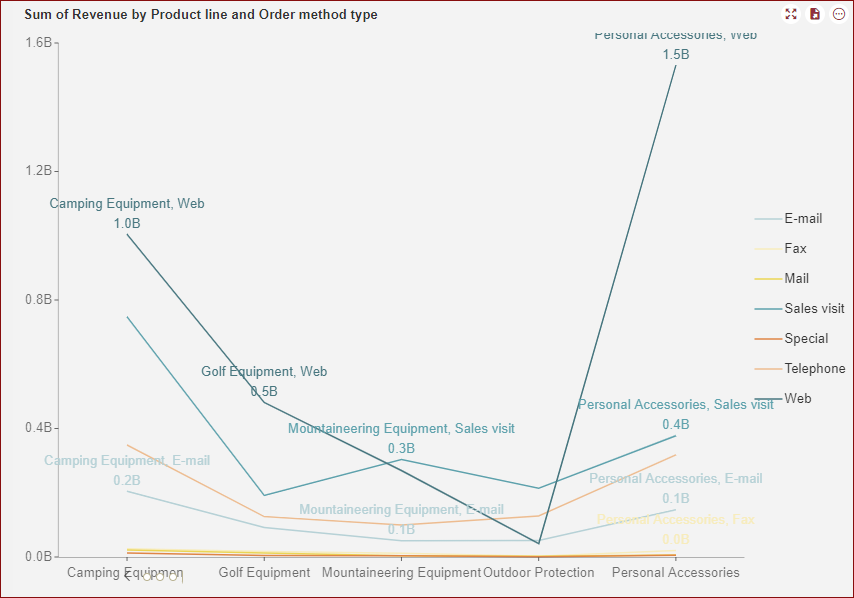- Getting Started
- Administration Guide
-
User Guide
- An Introduction to Wyn Enterprise
- Document Portal for End Users
- Data Governance and Modeling
- Working with Resources
- Working with Reports
-
Working with Dashboards
- Dashboard Designer
- Selecting a Dataset
- Data Attributes
- Dashboard Scenarios
- Dashboard Templates
- Component Templates
- 3D Scene
- Explorer
- Visualization Wizard
- Data Analysis and Interactivity
- Dashboard Appearance
- Preview Dashboard
- Export Dashboard
- Dashboard Lite Viewer
- Using Dashboard Designer
- Animating Dashboard Components
- Document Binder
- Dashboard Insights
- Add a New Page in Dashboard Designer
- View and Manage Documents
- Understanding Wyn Analytical Expressions
- Section 508 Compliance
- Subscribe to RSS Feed for Wyn Builds Site
- Developer Guide
Line Chart
Line charts are the most basic charts that are created by connecting the data points with straight or curved lines. These charts are used to visualize a trend in data by comparing values against periodic intervals such as time, temperature, etc. This chart is also used to depict the data values plotted over time to display the trends. It shows continuous data over time on an evenly scaled axis.

Design a Line Chart in Wyn Enterprise
From the Dashboard Toolbox, open the Data Visualization node and drag-drop the Line Chart scenario onto the design area.
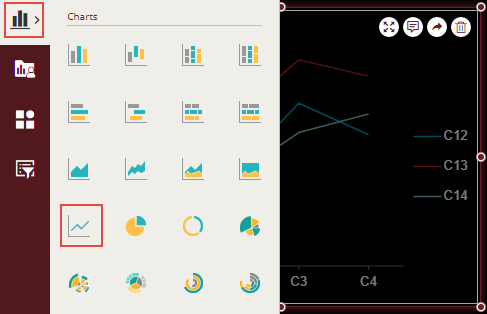
Bind Dataset to Chart Scenario
Select the dataset from the selected dashboard scenario under the Data Binding tab. Once the dataset loads successfully on the designer, the data binding panel automatically expands and displays the data attributes available for binding with data roles in the dataset. The following data roles are available for line charts,
Values: Displays values on the vertical axis of the line chart.
Axis (Category): Displays categories on the horizontal axis of the line chart.
Legend (Series): The side section of the line chart displays a description of each series on the chart.
Symbol Size: Symbols adjust size automatically based on data fields linked to the Symbol Size data role, streamlining symbol scaling in your visualization. In case the Symbol Size data role is not bound to a data field, the Symbol Size property on the Inspector Panel
Trellis Columns: With trellis columns, each column represents a distinct category and each subplot within that column displays a line chart for specific data.
Trellis Rows: With trellis rows, each row represents a distinct category or dimension.
Tooltip: Used to bind data fields to provide additional information about a data point on hover or click.
Drill Down: Drill down option to bind pre-set targets and paths. See the Drill Down help article for more information.
The following image shows the chart scenario bound to the TechnologyDataset dataset.
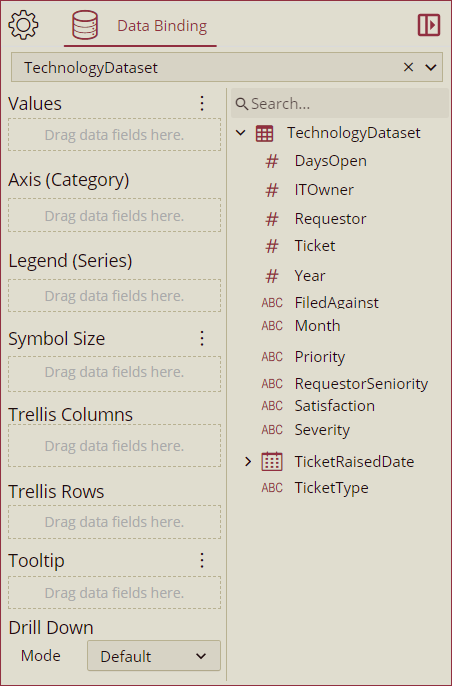
Drag and drop the data attributes to the data binding area of the scenario, the chart is plotted accordingly, with a default chart title on the design area.
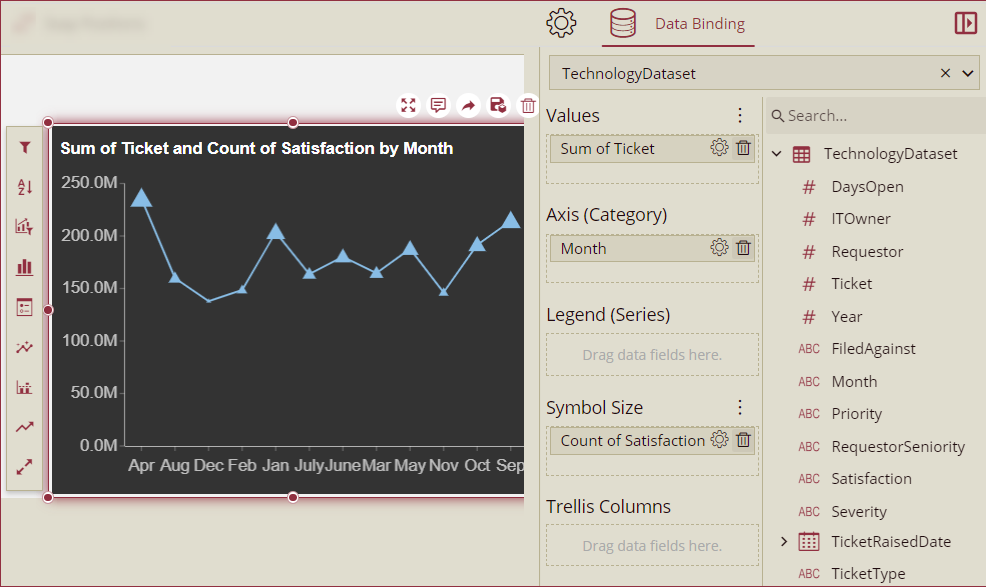
The data field bound to the Symbol Size data role will add a new property Size Range when the Show Symbol property on the Inspector Panel is set to True.

Format Data Attributes
You can format the data attributes and control the display of data by performing a variety of operations such as renaming, modifying data format, and display unit, creating a hierarchy field, applying an aggregation method, etc. Using these operations, you can control the display of data attributes in a scenario.
For more information about these operations, see Data Attributes.
In the following chart scenario, count aggregation is applied to the 'Ticket' attribute to show the count of tickets.

Analyze Data
Wyn Dashboards scenarios support rich data analysis and exploration capabilities that can help analyze massive amounts of information and make data-driven decisions. For example, adding filters to scenarios, sorting data, reference lines, trend lines, insight, etc. Note that you can apply all these operations using the Action Bar corresponding to each scenario in the designer.
For more information, see Data Analysis and Interactivity in Dashboards.
The following image shows filtered data in the chart scenario for the first six months i.e. Jan, Feb, Mar, Apr, May, and June.
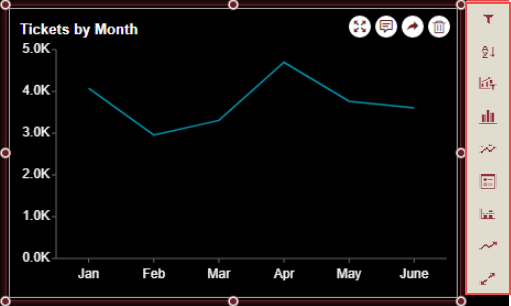
The line chart supports insights, and it has an Insight option in the action menu that shows insight without using the InsightIQ control. For details refer to the topic Dashboard Insights.
Customize Chart Appearance
You can customize the default chart appearance by setting properties in the Inspector tab of the scenario such as adding a border, modifying data labels, setting chart style, renaming chart title, changing line style, etc.
Change Axis Scale
To customize the scale values for the Value axis of a chart scenario, select the axis and set the Max Value, Min Value, or Interval properties.
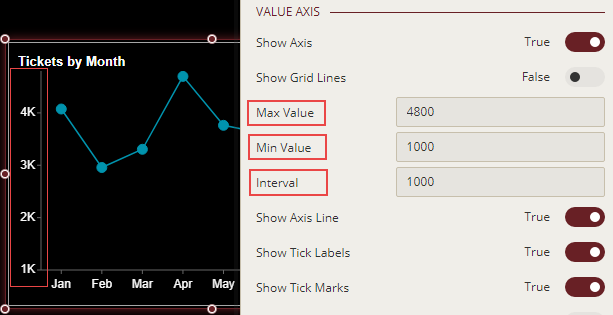
Reverse Value Axis Position
To reverse the direction of the Value Axis, set the Reversed property to True. By default, this property is set as False.
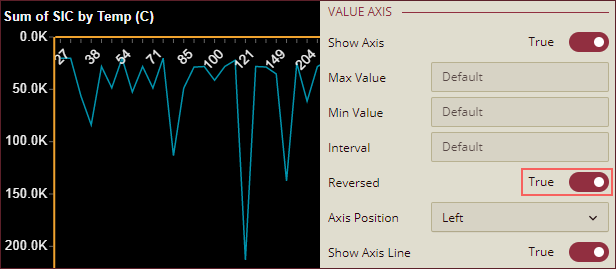
Change Axis Position
Axis (Category): To change the position of the Category Axis, use the Axis Position property dropdown to select an option from Crosses, Bottom, or Top. When Crosses is selected, Axis Crosses property appears below the Axis Position property where you can enter a value at which the Category Axis crosses the Value Axis.

Value Axis: To change the position of the Value Axis, use the Axis Position property dropdown to select an option from Left or Right.

Show Axis Lines
To hide the axis lines of the Value Axis or the Category Axis, set the Show Axis Line property to False. By default, this property is set as True. You can also specify the width, color, and type (solid or dashed) of the axis lines using the Axis Line Width, Axis Line Color, and Axis Line Type properties.

Show Grid Lines
To display horizontal and vertical grid lines in a chart scenario, set the Show Grid Lines property of the Value Axis and Axis (Category) to True. By default, this property is set as False. You can also specify the width, color, and type (solid or dashed) of the grid lines using the Grid Line Width, Grid Line Color, and Grid Line Type properties.

Format Axes Titles
You can show or hide axis titles for a chart by using the Show Title property for the Value and Category axes. When you set the Show Title property to 'True', the axis titles are enabled. Wyn Dashboards set data attributes' names as the axis titles. You can provide a custom name to the axis title by renaming the attributes in the data binding area. For more information on renaming data attributes, see the topic on Rename an Attribute.
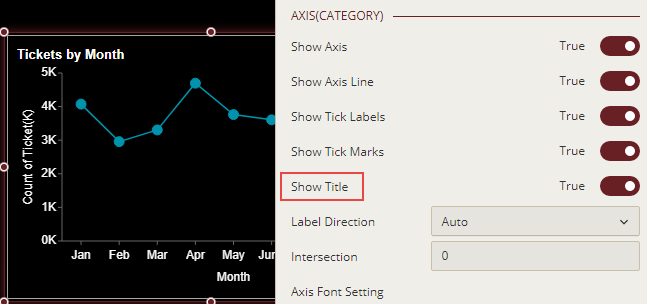
Change Line Style
By default, Wyn Dashboards use straight lines to connect the data points in a line chart. To change the default line style in the chart, use the Line Style property and set it to Spline or Step. In addition, you can specify the line type and width in the chart through the Line Type and Line Thickness properties, respectively. The available options for line type are Solid and Dashed.

Use Symbols for Data Points
Highlight the data points in a line chart to make them easy to read and understand. To do so, use the Show Symbol property of the scenario and set it to 'True'. Define the shape and color for the symbol through the Symbol Shape and Symbol Size properties. The supported shape types are dot (default), box, triangle, diamond, plus, and X. Furthermore, use the Symbol Fill and Symbol Stroke properties to set the symbol fill color and border color, respectively.
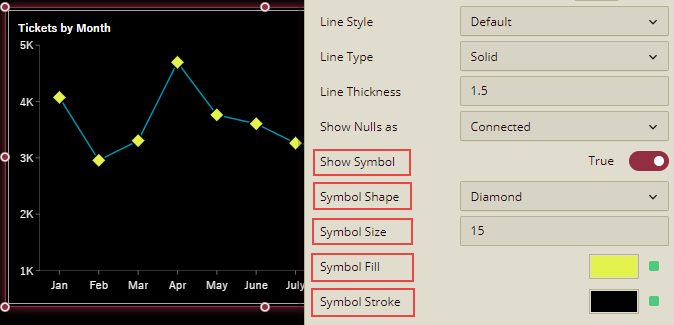
Format Data Labels
You can show or hide data labels in a chart using the Show Data Label property. When you set the Show Data Label property to True, the data labels are enabled. You can customize the data label's appearance using the Same Color As Legend and Data Label Font Setting properties. When you set the Same Color As Legend property to True, the color of the data labels changes to the same as the data points. However, Data Label Font Setting allows you to set font style and color as per your choice.
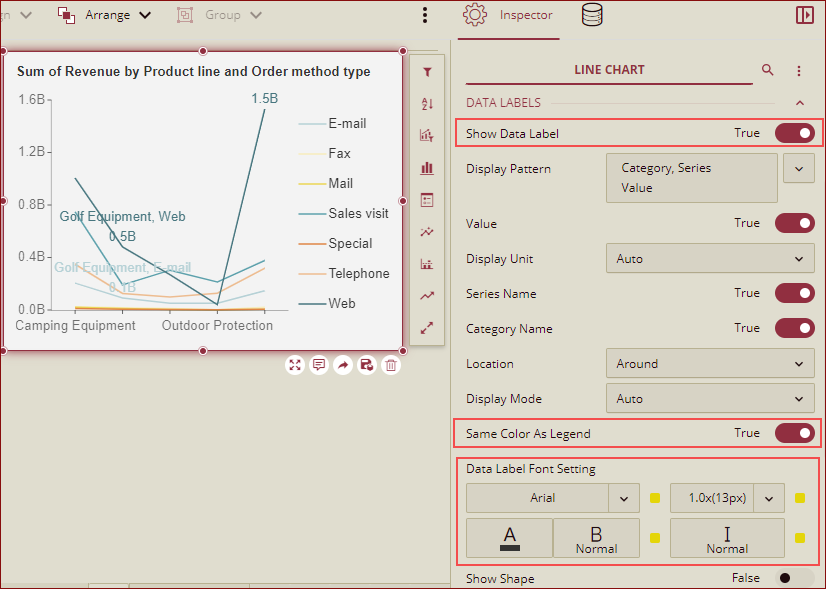
Data Labels - Display Pattern
The line chart supports the line break in the data label, and you can add a line break between Category, Series, and Value, by using the Display Pattern property for the data labels as shown below.
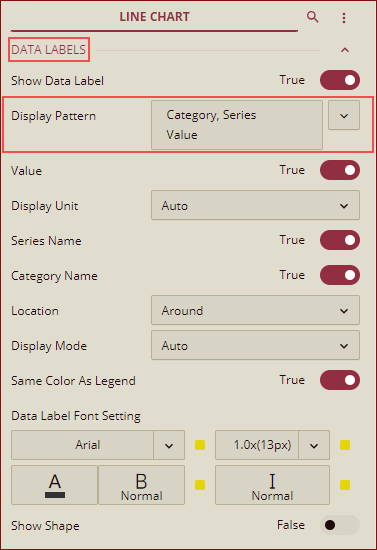
You can select any pattern from the dropdown list.

Preview the chart, the data labels will be shown as per the display pattern selected in the designer.
